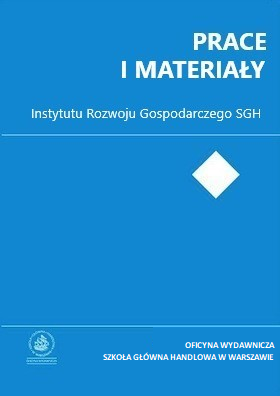Nowe metody analizy danych a teoria ekonomii
##plugins.themes.bootstrap3.article.main##
Abstrakt
W niniejszym opracowaniu przedstawiliśmy związki między współczesnymi trendami w badaniach ekonomicznych a nowymi metodami analizy danych. Jako reprezentanta nowego nurtu analizy danych wybraliśmy metody ślepej separacji. Jest to dynamicznie rozwijająca się gałąź analizy danych, która zapoczątkowana pewnymi badaniami neurofizjologicznymi, przekształciła się w szerokie spektrum podejść rozważanych w kategoriach metod separacji, reprezentacji oraz transformacji danych. Do zasadniczych technik w tym obszarze należą przede wszystkim: analiza składowych niezależnych, nieujemna faktoryzacja macierzy oraz algorytmy AMUSE oraz SOBI. W drugiej części opracowania rozważamy różnice pozyskiwania wiedzy w podejściu indukcyjno-eksploracyjnym, którego reprezentantem mogą być metody separacji, a podejściem aprioryczno-dedukcyjnym typowym dla ortodoksyjnych nurtów ekonomii. Wykazujemy, że wbrew często opozycyjnemu ich przedstawieniu są to zasadniczo podejścia komplementarne. W naszej interpretacji wybór podejścia jest związany z relacją ilości danych do wielkości wiedzy eksperckiej o zjawisku.(abstrakt oryginalny)
##plugins.themes.bootstrap3.article.details##
Bibliografia
Berry M., Browne M., Langville A., Pauca P., Plemmons R., Algorithms and Applications for Approximate Nonnegative Matrix Factorization, ”Computational Statistics & Data Analysis” 2007, vol. 52, no. 1, s. 155–173.
Blaug M., Metodologia ekonomii, PWN, Warszawa 1995.
Blaug M. Teoria ekonomii: ujęcie retrospektywne, PWN, Warszawa 2000.
Cao X.-R., Liu R.-W., General approach to blind source separation, “IEEE Transactions on Signal Processing” 1996, vol. 44, no. 3, s. 562–571.
Cichocki A., Amari S., Adaptive Blind Signal and Image Processing, John Wiley, Chichester, 2002.
Cichocki A., Zdunek R., Phan A.-H., Amari S., Nonnegative Matrix and Tensor Factorizations: Applications to Exploratory Multi-way Data Analysis. John Wiley, 2009.
Cichocki A., Unbehauen R., Robust neural networks with on-line learning for blind identification and blind separation of sources, „IEEE Transactions on Circuits and Systems I: Fundamentals Theory and Applications” 1996, vol. 43, no. 11, s. 894– 906.
Comon P., Independent Component Analysis, a new concept?, “Signal Processing” 1994, vol. 36, no. 3.
Comon P., Jutten C. Handbook of blind source separation: independent component analysis and blind deconvolution, Oxford; Burlington, Academic Press/Elsevier, 2010.
Czerwonka M., Gorlewski B., Finanse behawioralne, Wydawnictwo Oficyna Wydawnicza SGH, Warszawa 2012.
Dębiec J., Problemy determinizmu i wolnej woli w neurobiologii — neuroekonomia Paula Glimchera, „Zagadnienia Filozoficzne w Nauce” 2004, XXXIV.
Flexer A., Makeig S., Correlation of Subjective Expectation and P300 Amplitude during a Game of Matching Pennies, Technical Report, Oesterreichisches Forschungsinstitut fuer Artificial Intelligence, Wien, TR-2004-19, 2004.
Frydman R., Goldberg M., Imperfect Knowledge Economics – Exchange Rates and Risk, Princeton University Press, 2007.
Glimcher, P., Decisions, Uncertainty, and the Brain: The Science of Neuroeconomics, The MIT Press, Cambridge, Massachusetts, 2003.
Globler A. Metdologia nauk, Wydawnictwo Znak, 2006.
Hérault J., Jutten Ch., Space or time adaptive signal processing by neural network models, International Conference on Neural Networks for Computing, Snowbird 1986.
Hicks J.R. Perspektywy ekonomii, PWN, Warszawa 1988.
Huerta de Soto J., Pieniądz, kredyt bankowy i cykle koniunkturalne, Wyd. Instytut Ludwiga von Mises, 2009.
Hyvärinen A., Karhunen J., Oja E., Independent Component Analysis, John Wiley, 2001.
Jaynes E.T., Probability theory the logic of science, Cambridge Univ. Press, 2003.
Jutten C., Hérault J., Blind separation of sources, Part 1: An adaptive algorithm based on neuromimetic architecture, “Signal Processing” 1991, vol. 24, s. 1–10.
Kacprzyk J., Neuroeconomics: Yet Another Field Where Rough Sets Can Be Useful?
Proceedings of RSCTC'2008, 2008.
Keynes J.M., Ogólna teoria zatrudnienia, procentu i pieniądza, Wydawnictwo Naukowe PWN, Warszawa 2003.
Kisielewicz A., Sztuczna Inteligencja i Logika. Podsumowanie Przedsięwzięcia Naukowego WNT, 2011.
Lee D.D., Seung H.S., Learning the parts of objects with nonnegative matrix factorization, „Nature” 1999, no. 401.
Lakatos I., Renesans empiryzmu we współczesnej filozofii matematyki, w: Współczesna filozofia matematyki, red. R. Murawski, PWN, Warszawa 2002.
Magee B., Historia Filozofii, Wydawnictwo Arkady, 2000.
Matsuoka K., Kawamoto M., A neural net for blind separation of nonstationary signal sources, IEEE Symposium on Circuits and Systems, 1994, s. 221–226.
Mayer T., Prawda kontra precyzja w ekonomii, PWN, Warszawa 1996.
Nowak R., Statystyka dla fizyków, PWN, Warszawa 2002.
Penrose R., Nowy umysł cesarza: o komputerach, umyśle i prawach fizyki, PWN, Warszawa 1995.
Piegat A., (2011.09.30) Nowa, kompletnościowa interpretacja prawdopodobieństwa, strona autora: http://wikizmsi.zut.edu.pl/wiki/Publikacje Plumbley M.D., Algorithms for nonnegative independent component analysis, „Neural Networks” 2003, vol. 14, no. 3.
Putnam H., Wiele twarzy realizmu i inne eseje, PWN, Warszawa 1998.
Snowdon B., Vane H., Wynarczyk P., Współczesne nurty teorii makroekonomii, Wydaw. Naukowe PWN, Warszawa 1998.
Szupiluk R. Metody redukcji i estymacji szumów przy estymacji i separacji sygnałów statystycznie niezależnych, Politechnika Warszawska, 2002.
Taleb N. Ślepy traf, rola przypadku w sukcesie finansowym, Gdańskie Wydawnictwo Psychologiczne, 2006.
Woleński J,. Epistemologia, Aureus, Kraków 2000.
